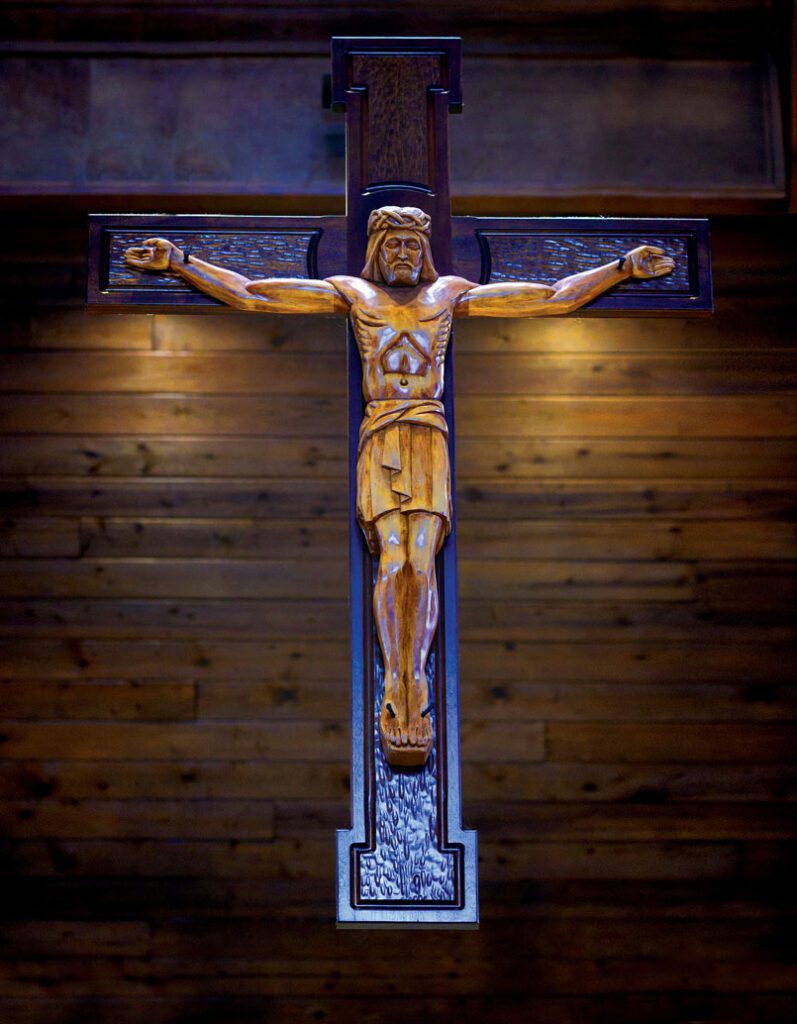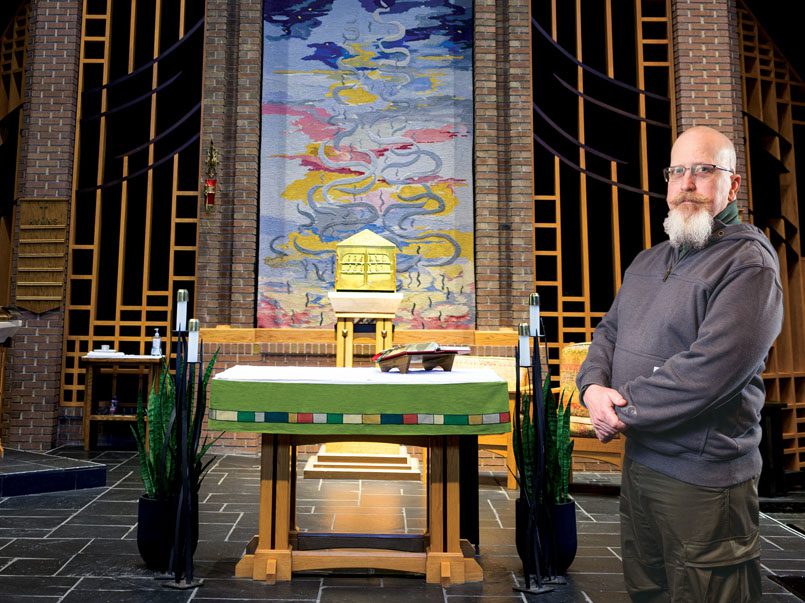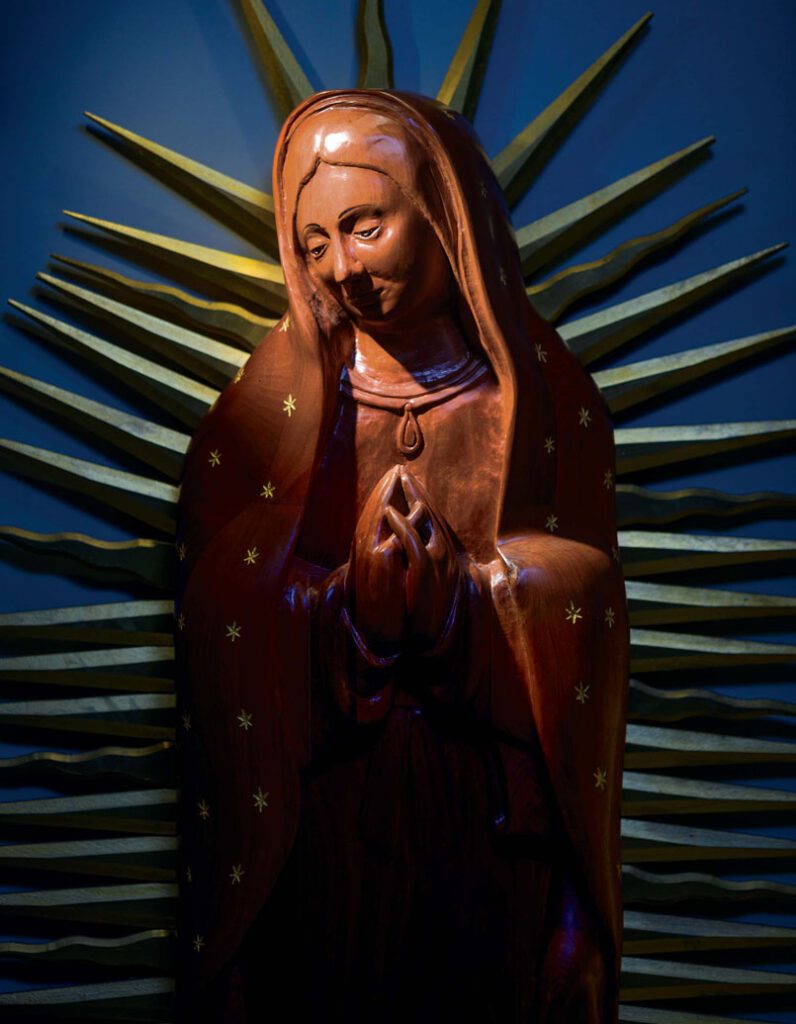28 Feb 2023 Touching the face of God
By Dwain Hebda
One of Michaelangelo’s most famous quotes came at the inquiry of where his inspiration for carved statues came from.
“Every block of stone has a statue inside it,” the great master is supposed to have replied, “and it is the task of the sculptor to discover it.”
Liturgical artist George Hoelzeman chuckles at the well-worn quote and the sly hint it provides that art has always been a terse dance between talent and marketing, a reality experienced by even one of the greatest artists who ever lived.

“There’s a lot of work involved in creating art. Especially, there’s a lot of work involved that doesn’t look like work to most people,” Hoelzeman said. “To develop something that’s meaningful and yet beautiful and artistic, there’s this long creative process. The reality is you sit there, and you look at it. You can think you’re doing nothing because you’re just staring off into space, but your brain is just plowing through ideas.
Another knowing chuckle.
“Michelangelo can say what he wanted to, but he was actually promoting his own legend at that point.”
It’s been more than three decades since Hoelzeman delivered his first commissioned project, a series of plaques depicting the Stations of the Cross for St. Augustine Catholic Church in North Little Rock. In the time since, he’s become a sought-after artist for sacred spaces, creating artwork and sanctuary elements such as tabernacles and altars for faith communities in multiple states.
It’s a complicated line of work, interpreting the image of God in ways that are creative enough to provoke thought, yet familiar enough to connect a congregation – individually and collectively – in ways known and comforting.
“It is an indescribable experience to see and hear of people being moved by one’s work in a way that heals, uplifts, encourages, inspires or otherwise draws a person more deeply into the spiritual life,” Hoelzeman said. “Ultimately, one has to silence one’s own conceit and recognize that God will and does use the work as He sees fit. The piece, or pieces, have their own life, even in the process of being designed and made.”
The son of a carpenter, Hoelzeman graduated from Sacred Heart School in Morrilton. He initially saw his path leading to the priesthood, and after completing St. Joseph Seminary in Covington, La., the plan called for entering Subiaco Abbey in Subiaco (Logan County).

“I kept holding out the idea that I was going to go back to monastery until I met my wife and then it was like, ‘OK, I think I know where I really want to be now,’” he said with a laugh.
Hoelzeman’s path in life may have changed, but his formation up until that point had already permeated the way he viewed the world, particularly through his art.
“I was apparently pouring a lot of the monastics, spirituality and stuff into it even before I knew that I was,” he said. “In about 1986, 1987, I was going around trying to market myself as a freelance artist to various ad agencies in Little Rock. In an interview, one of the art directors down there said, ‘Have you considered doing religious art?’ I said, ‘Why do you say that?’ He said, ‘Everything that you’ve done has a religious or spiritual theme to it.’ I didn’t even recognize it at the time.
“Somebody I knew at the time had a book called ‘What Color is Your Parachute?’ It was one of these self-help things to help you figure out what to do with your life. I read it and took the little test and at the end of it, I concluded that my best options were either A, go back to the monastery and be a monk, or B, do something that had to do with art, history, theology, the church, etc. So, that pointed me to liturgical art.”
Today, a monastic influence still radiates throughout his work, starting with his preferred medium, wood carving. As a religion, Roman Catholicism is rich with symbolism, and in assessing his work, Hoelzeman views his art through that lens.
“Wood is living and gives life, both as a tree and a material for art and construction,” he said. “In life, trees produce oxygen, which is essential for our life. They also purify the air and they accomplish all this by their silent presence. I think this is a good model for our life in Christ and is particularly meaningful in the context of my monastic background. Trees are a common symbol throughout Scripture going back to the creation story in Genesis.

“Trees also endure, sometimes, centuries of the challenges of survival. These hardships and injuries are recorded in their wood, and in that wood those sufferings are transformed into incredible beauty. The more a tree has been traumatized, the more spectacular is the figure of its wood. Again, I find this a meaningful metaphor not only for the passion of Christ, but our own challenges in living a life in Christ.”
Hoelzeman’s talent shines in finished pieces, imbued as they are with a certain irresistible life force. He’s visited churches where his artwork has been installed and seen lipstick on the pieces, so moved were people to kiss an image as a sign of devotion. He said all good work connects with its audience similarly, the distinction between true art and a manufactured commodity, another tightrope every creative must navigate.
“One of the things that drives my colleagues and I nuts are parishes that go straight to a catalog because that’s all they know,” he said. “Well, that may look nice and pretty, but it’s just manufactured; it doesn’t have the same life and depth. It’s not the same experience.
“There have certainly been times when I felt like I was starting to get into a creative rut and I needed to expand my horizons. If you don’t do that, you’re not an artist anymore and you’re certainly not a liturgical artist anymore. You’re just a manufacturer. You’re just going to shrivel up and die as an artist, as a creative person, or frankly, as a human being.”
Another cause for Hoelzeman’s zeal for the process is that for as much as his finished work gives his audience, it’s the unfinished work in progress that continually refreshes his own wellspring of faith.
“Monastic spirituality has taught me the critical importance of humility,” he said. “As such, I don’t really think in terms of God owing me any favors or special treatment. God doesn’t owe me anything. When I’m working on a sculpture, I am aware that I’m taking that which was created by God and applying abilities, which He has seen fit to bless me, in order to create something of beauty that draws others to goodness and truth – in other words, to God himself.
“The challenges and difficulties I face in the process are part of the way I can advance my skills and vision. Likewise, the difficulties of life are crucial to spiritual growth and maturity, God’s way of teaching me humility as well as faithful patience.”
- Conway couple called to serve foster children, families - March 10, 2024
- Artist of the Month: Terri R. Taylor - November 5, 2023
- Everybody loves a nut - November 5, 2023











